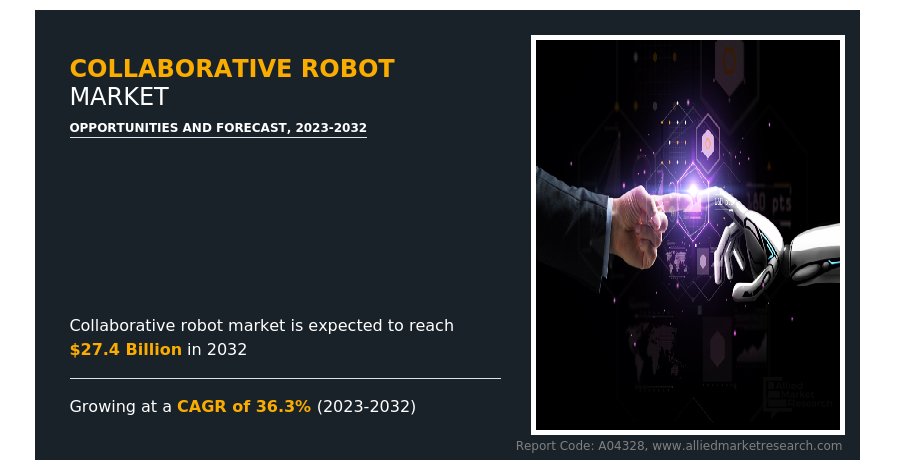Unlocking the Potential: Collaborative Robot Market Set to Reach $27.4 Billion by 2032
Collaborative Robot Market
The emphasis on worker safety and compliance with stringent safety standards drives the growth of collaborative robot market
In recent years, the demand for collaborative robots, or cobots, has been steadily increasing across various industries. Unlike traditional industrial robots that are designed to work autonomously in isolated areas, cobots are designed to work alongside human workers in a collaborative manner. This shift towards human-robot collaboration has been driven by the emphasis on worker safety and the need to comply with stringent safety standards in the workplace.
Collaborative robots are equipped with advanced sensors and intelligent software that enable them to work safely alongside humans without the need for safety cages or barriers. This makes them ideal for tasks that require close human-robot interaction, such as assembly, packaging, and quality inspection. By automating repetitive and hazardous tasks, cobots can help improve workplace safety, increase productivity, and reduce the risk of injuries for human workers.
According to a report published by Allied Market Research, the global collaborative robot market is projected to reach $27.4 billion by 2032. This significant growth can be attributed to the increasing adoption of cobots in various industries, including automotive, electronics, healthcare, and food and beverage. As companies strive to enhance operational efficiency and stay competitive in the market, many are turning to cobots to streamline their production processes and improve overall productivity.
With advancements in technology and the development of more sophisticated cobot systems, the potential applications for collaborative robots are virtually limitless. From small businesses to large enterprises, companies are recognizing the benefits of incorporating cobots into their operations. By leveraging the capabilities of cobots, businesses can optimize their manufacturing processes, reduce labor costs, and increase their overall profitability.
As the collaborative robot market continues to expand, it is clear that cobots are revolutionizing the way we work. By unlocking the potential of human-robot collaboration, companies can create safer, more efficient work environments that benefit both their employees and their bottom line.
In conclusion, the collaborative robot market is poised for significant growth in the coming years, driven by the increasing emphasis on worker safety and compliance with stringent safety standards. As businesses across various industries continue to adopt cobots to improve their operations, the global market for collaborative robots is expected to reach $27.4 billion by 2032. This growth represents a major opportunity for companies to enhance their productivity, streamline their production processes, and create safer workplaces for their employees.
How This Will Affect Me?
For individuals working in industries that are adopting collaborative robots, this growth in the collaborative robot market will likely have a positive impact on their workplace environment. By incorporating cobots into their operations, companies can improve worker safety, increase productivity, and create more efficient workflows. This can lead to a safer and more rewarding work experience for employees, as well as potential opportunities for upskilling and career development in the field of robotics.
How This Will Affect the World?
On a global scale, the expansion of the collaborative robot market signifies a shift towards more sustainable and efficient manufacturing practices. By leveraging the capabilities of cobots, companies can reduce their environmental impact, optimize their resources, and meet the increasing demand for high-quality products in a competitive market. Additionally, the growth of the collaborative robot market has the potential to create new job opportunities in the field of robotics and automation, driving innovation and economic growth worldwide.





